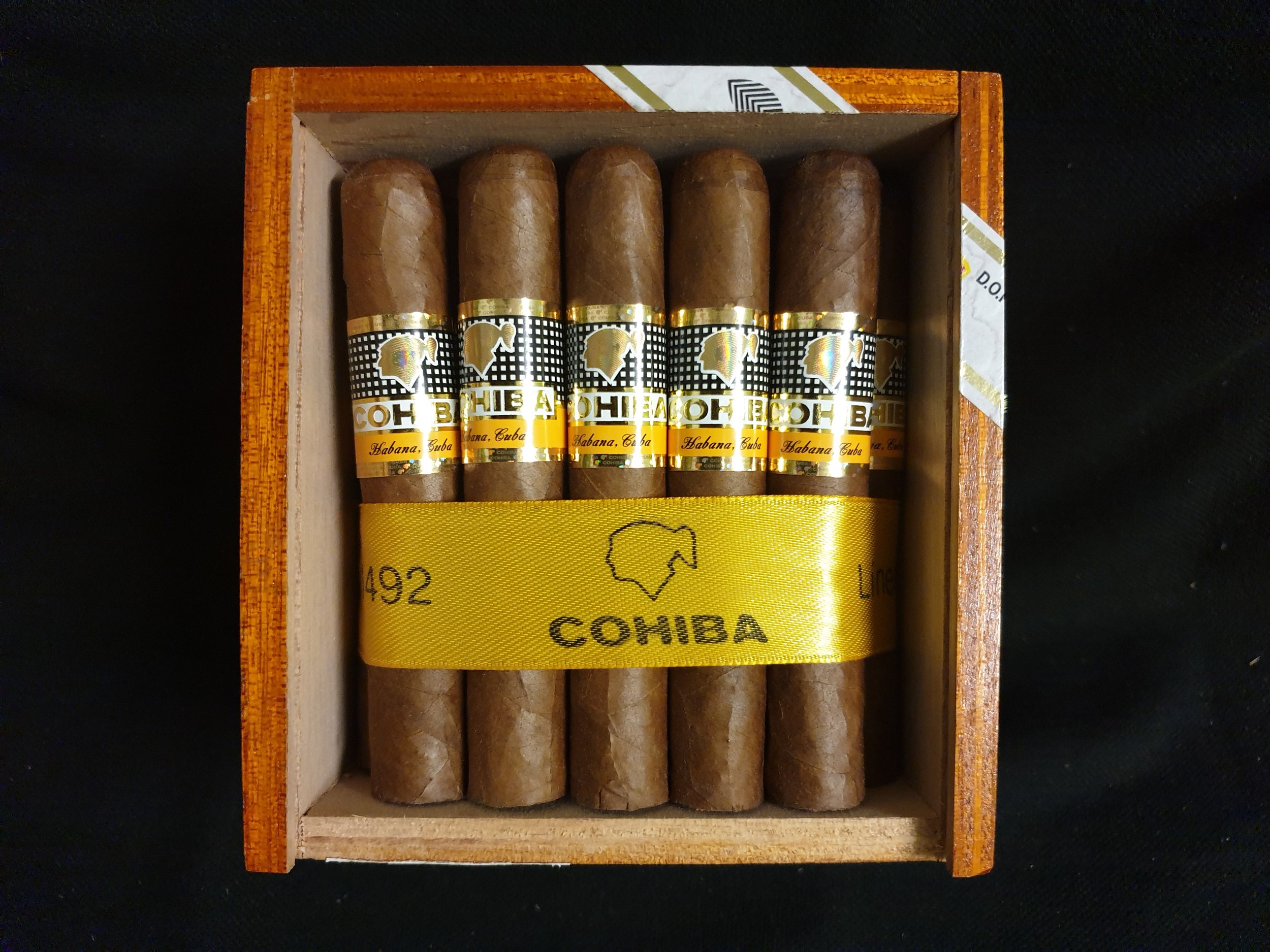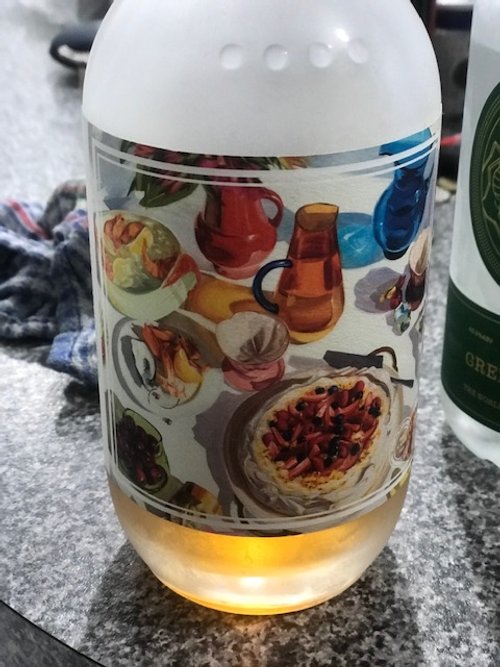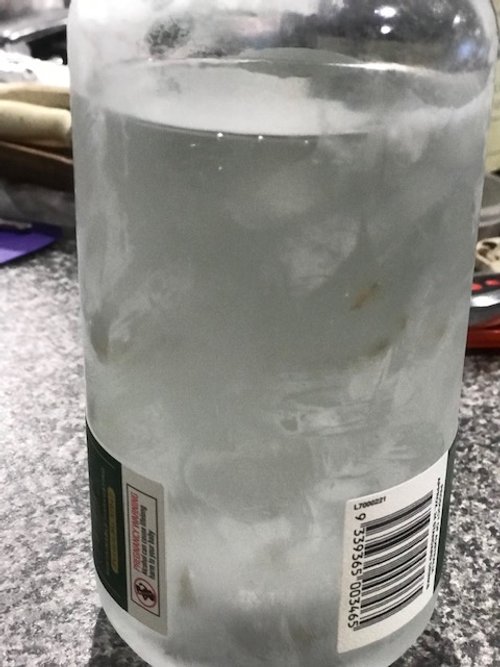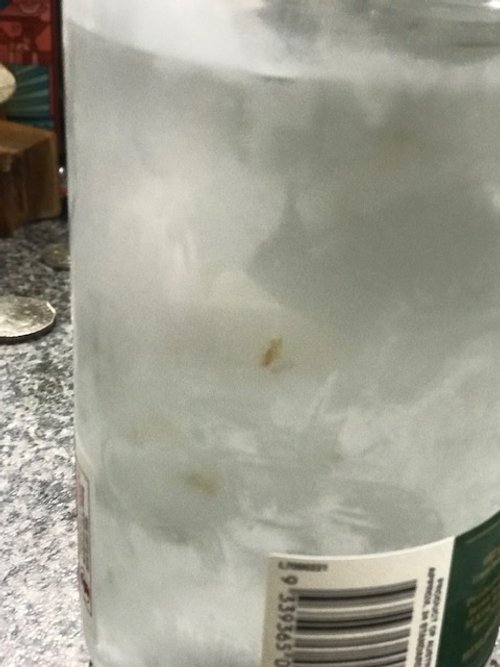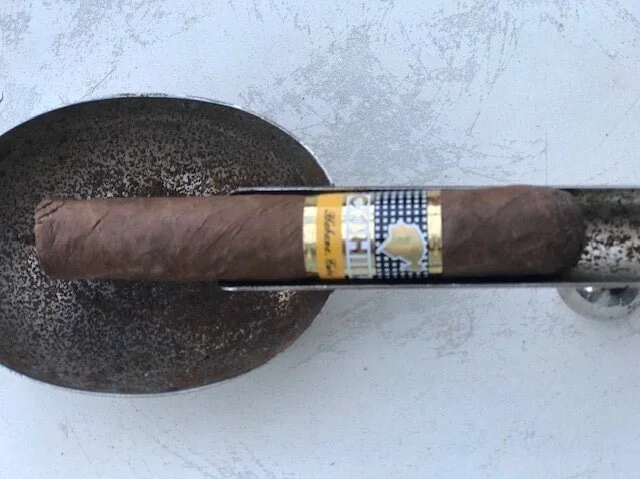Cohiba Siglo 1 – Four Pillars Christmas Gin
Okay, granted I have been a little slack in keeping up with the Kenfessions, but never fear, back in the saddle, so to speak. And after the ‘I’ve never had a Gurkha before’ snafu, it was onwards and upwards. Well, sort of.
A small issue. Turns out that the rave reviews of a wonderful Juan Lopez No 2 had to be canned as I'd matched it with, and oh how I wish I was making this up, the Lustau 125th Anniversary ‘1996 Añada’ Vintage Sherry. Yes, the very same wine that I matched with the ‘first ever bar one’ Gurkha I’ve ever tried. Embarrassing. So into the bin with that piece as well. I'd insert a joke about early onset here, but it is feeling a smidge too close to the bone at the moment. Anyway, I figure that I have been so slack of late, you deserve a big effort here. So a bit longer than usual (which some might see as a punishment). Don’t get used to it.
Back to the humidor. Floating around, a small Cohiba, all alone. That will do. So, out came a Cohiba Siglo I of unknown age. First thing to note was that it was seriously spongy. Yes, not a ringing endorsement, but with the endless rain we have had over the last few months (yeah, tell me again there is no such thing as climate change), anything that had not sprouted shoots was a positive. Serious humidity here.
Surprisingly, the humidity did not seem to diminish the cigar at all. Well, perhaps it did but that would mean it could have been even better. If that makes sense. I took it with me for a family weekend, my brother-in-law’s 60th, which we had somewhere north of whoop whoop. Lovely homestead and a really nice weekend, but I was in the back seat with my sister driving us to get there. Now, google directions told us to expect a journey of two hours forty minutes. Everyone else took around that time. I was dreading this as I am not good in the back seat at any time and especially for so long.
Ha! If only. Four hours and twenty minutes. My sister believes that one should stop before driving through any slight potential pothole or dip or even if there is a feather on the road. So when we arrived, I needed both a cigar and a drink. So settled in on the balcony, great view though it was a wet weekend, with the cigar, my cocktail and Don Winslow’s brilliant conclusion to his Mexican drug trilogy, ‘The Border’.
The cigar was rich and toasty and quite powerful. Notes of cream and (yes) caramel with some tropical notes. Just lovely. For me, 93. Well balanced, some maturity and complexity and no bumps at all. Sadly, it took but a fraction of the time I was entombed in the car.
To drink?
The match for the cigar is my current favourite cocktail. Normally I am not a big cocktail guy, but recently I came up with my all-time favourite version of a Gin & Tonic. A lovely big glass – I use the Riedel ‘O Series’, Pinot/Nebbiolo glasses, stemless, which I find are brilliant for great rums as well. The major component of this cocktail is one of the more curiously odd gins around, the Four Pillars Christmas gin.
Into the glass, a reasonable whack of ice-cubes. Then a blend of around 40/60 Four Pillars Christmas Gin and your favourite tonic. Finally, take a fresh lime and slice it however appeals and add the lot. Squeeze a few of the slices. Heaven.
Been doing heaps on gin of late. Rob very kindly part 1 of a piece I did for Quill and Pad on gin (https://www.friendsofhabanos.com/forum/topic/152239-gincredible-how-and-why-gin-went-from-murderous-swill-to-007-level-cool/#comment-1142251). The second part, I intend to steal from (can one plagiarise oneself?) for this piece so apologies to both readers of Quill and Pad.
The story of Christmas Gin is largely a tribute from their head distiller, Cam McKenzie, to his late mum, Wilma. Cam was in the wine industry (well, pretty much all the 4P team was before they won the jackpot with their gins), but he was also an international athlete. Okay, you’d probably have to be the greatest living sports trivia nerd to know about Cam, but he was a middle-distance runner who represented Australia at the Atlanta Olympics. So he was no mug, although as his partner, Stu Gregor, has been heard to say, Cam was downtown when the bomb went off. Stu reckons Cam ran back to the Olympic Village faster than he ran in his race. As for Cam’s tales of the Olympics, he once said that the stories about what went on behind closed doors and in the dead of night at the Olympic Village was absolutely true. As he said, “I could have had any East German weightlifter I wanted”. No one in the audience showed such poor form to point out to Cam that East Germany ceased to exist some six years before those Olympics, but we knew what he meant. Any wonder the world of gin is a strange one.
Anyway, Wilma would make the family’s annual Christmas pudding using the old 1968 Australian Women’s Weekly recipe. Cam makes it now but not just for the family, he uses it for his Christmas gin. He puts them into the botanicals basket and infuses the gin. And there we have this wonderful spirit. There is more to it, of course, but the result is one of my fave 4P gins.
So where does it fit in the weird world of gins (yes, here is the plagiarised-ish bit). Ask yourself, what do truffles, Harley-Davidson motorcycles, trout, elephant dung and green ants have in common?
Green ants, by the way, were the bane of every Aussie kid’s life when I was young, an era before video games and computers when we’d play outdoors with our mates. If you tackled on a green ant nest, you were guaranteed a bundle of itchy, very painful bites. But I digress. Those items, and countless more, have all been used to make specialist craft gins. Sure, gin needs juniper, but after that it is open slather. Indeed, it is hard to think of a plant, herb, root, flower, leaf and much more than has not been used to make gin.
Gin distillers have become more prevalent than political pundits, and I know which the world is better off having. Everyone wants and needs their gin to be different as it competes with battalions of bottles from around the globe. It seems highly unlikely that we shall ever unravel the timeline of just who started all this, but my suspicions are that it was an evolution. One distiller tried something. The next would push the envelope just a fraction more. And so on until we had a fully-fledged revolution on our hands. Every day, it seems there are new, weird gins. Undoubtedly, a lot of the credit for being the bridge from terrific traditional gins to exciting craft gin must go to Hendricks and Bombay Sapphire. In Australia, Four Pillars kicked it off (oaky, others have claims but for me, we are going with 4P) with its now incredibly popular Bloody Shiraz Gin, made by macerating some quality Shiraz grapes in the gin. For me, Cameron McKenzie and Stu Gregor are the gin versions of Willy Wonka and PT Barnum.
I remember a delightful, delicious Black Truffle Gin from the Stone Pine Distillery in South Australia (its Orange Blossom Gin was popular at Noma). The founder went on a truffle hunt to source the truffles himself. Dedication. Truffle gins have been made from the UK to the Kalahari.
Green ants? Several Adelaide Hills (better known for terrific wine, but a region devastated by bushfires) distilleries released Green Ant Gins in past years. I am very glad I didn’t have to collect the ants.
I am currently enjoying the Green Ant gin from Seven Seasons – and this is really embarrassing: just checked the freezer to confirm I had the correct details of the gin and wondered what the hell was floating in my gin? Yes, green ants. I had simply not noticed them before. I am loving it. As they say, the ants taste like lime and coriander (as do lime and coriander). Surely someone sent a bottle to the Marvel people to go into the next Antman movie? And these were not the first ant gins made. A team in Cambridge used red wood ants, a strict 62 ants per bottle. (And you thought this wasn’t going to get any weirder.) By the way, Applewood is rumoured to have even used the durian fruit in making gin. For those not familiar, it is considered by many as the greatest, and certainly most controversial, of all fruits. My favorite description (and I love the stuff) is that it is like “eating custard over an open sewer.”
Concerned about the morning after? A Melbourne distillery, The Myrcene Hemp Gin Company, made what it has called the “world’s first cannabis gin with terpenes” and named it “The Cannabis.” It sold out in three days.
Every place has its own botanicals, hence the extraordinary range of different options for distillers. The excellent range of Tasmanian gins from Dasher & Fisher include such intriguing ingredients as wakame seaweed and native pepperberries. Australia has some 24,000 indigenous plants so we have a long way to go.
New Zealand has plenty of its own botanicals of course: Kawakawa, Horopito, and Manuka for example. Manuka honey is internationally famous (there are debates as to just what extent the Kiwis can claim Manuka as it is also native to parts of Australia but New Zealand has never had a problem stealing all manner of things – kiwifruit my fat bottom). The others are New Zealand plants/trees.
Another botanical recently encountered is gunpowder green tea. Nothing is off limits. Quandong Gin, anyone (a native fruit)? How about using pigface? Well, it sounds better when you call this small native fruit by its aboriginal name of karkalla. Not strictly Aussie, though made by one in Southeast Asia, Iron Balls Gin includes coconuts, pineapples, ginger and lemongrass.
Australia is but a drop in the bucket when it comes to odd gins. Allow me to offer you some international options.
From the Cape District in South Africa, I give you Fynbos Gin. Fynbos is, if I have this right, a small area near the Franschhoek mountains with many native botanicals. Buchu and kapokbos, anyone? But it is positively mainstream compared to many. Whitley Neill, originally from London but now living and distilling in South Africa, offers Gin Baobab using fruit from the baobab tree and gooseberries.
We are just warming up.
Even though countries like Spain and the Philippines drink more gin than the UK, many automatically think England when thinking gin, yet around 70 percent of the gin made in the UK comes from Scotland. One would have thought those distillers would be too busy creating their great whiskies. Apparently not.
The obvious one is the fabulous Hendricks, first released back in 2000. Most of us think cucumber when we think Hendricks (not your obvious gin component, and this really was one of the very early “weird” gins, but it succeeded because it is simply so good), but there are numerous flavors here, not least rose petals. As I mentioned, this was one of the bridge gins for me. Among the florals they use are Bulgarian rose petals (I’d like to think Philip Pullman might have been sipping on Hendricks while he wrote the volumes of The Book of Dust, which will only make sense if you have read them).
One way to differentiate your gin from your neighbouring distiller is alcohol level. Strane has done this with its Uncut London Gin, which comes in at a whopping 76 percent. So, a sip of your Strane or an entire bottle of wine? Same effect.
I’m not sure I’ve encountered any gin using more botanicals than the wonderful Monkey 47, but plenty use more than 20. Of course juniper is crucial to gin, but many feature something a bit interesting.
For example, another Scottish gin, Eden Mill from the famous golfing town of St. Andrews, uses sea buckthorn, one of the very many botanicals, herbs, plants and concoctions used in gins around the world that are completely unfamiliar to me.
I promised you trout. Well, sort of. Google “Battenkill Gin” – Battenkill is a trout stream in the United States. Each bottle supposedly has a tiny baby trout in it, much like the Mezcal worm. It is said that if you swallow the fish, you’ll have good luck on your next fishing trip. I was ready to believe it. If we can have motorcycle parts, what is so weird about trout? But it was, apparently, an elaborate and extremely successful April Fools’ Day prank.
If Moonshot Gin from the That Boutique-y Gin Company is not an April Fools’ Day prank, it should be. All of the botanicals used for this gin, including juniper, coriander, chamomile flowers, fresh lemon peel, cardamom, dried bitter orange peel, cinnamon, cubeb pepper, licorice root, angelica and moon rocks (part of a meteorite) were all flung into space, 24 kilometers high, to where the pressure is 1/100th that at sea level, and then vacuum distilled on their return at a pressure 1/16th that at sea level. The claim is that it “increases freshness and elegance.” Look for it in the next Star Trek movie.
You think that is batshit crazy? Let me give you The Archaeologist Gin. Well, I have no intention of actually giving you any as each bottle will set you back over a grand. Uwe Ehinger from Germany is apparently fond of two things: motorbikes and alcohol (though hopefully not at the same time). Ehinger decided to combine his passions (he is famous as a manufacturer of custom-made motorbikes and a dedicated seeker of old motorbikes, wherever in the world they might be – hence, “the archaeologist”). So he made a gin and called it just that. Infused with actual vintage Harley-Davidson parts, it is also apparently not a prank. In each bottle, you’ll find a different part from a Harley that Ehinger has found somewhere. The list includes 1939 Flathead camshafts from the Mexican desert, 1947 Knucklehead screw-nuts from Chile, and 1962 Panhead rocker arms from South Korea (I have absolutely no idea what any of those things are, but apparently they form part of a Harley). The parts are cleaned and sealed with a tin alloy, making them safe to go in the bottle (and kind of defeating the purpose, one would have thought). Each release sells out immediately.
London-based Portobello Road Gin offered as part of its Director’s Cut series a gin made by distilling turkey breasts. At least they were organic turkeys.
Other botanicals used have included apples, pears, plums, currants, raisins, sultanas, apricots, brown rice (seriously? This is sounding more like dinner than drinks), passionfruit, cinnamon, cassia bark, nutmeg, and mace.
Young in Spirits makes a gin distilled with collagen. At least it has a nifty name: CollaGin.
That Boutique-y Gin Company does more than simply send stuff into space. It also offers – and it really doesn’t get much more down to earth than this – Dead King Gin. The aim was to feature the aromas one encounters from a freshly unwrapped Egyptian mummy – I’ll have to take their word for that, but I really want to know how on earth they came up with that idea. Who wakes up and says let’s make a gin that smells like a 3,000-year-old corpse? Or am I simply behind the times? The distillery achieves that by using botanicals that were traditionally utilized in the embalming process such as rosemary, honey, moss, and myrrh (so apparently myrrh is a real thing – who knew? Certainly not my Sunday School teacher). It also makes gin with hot sauce and another called Bog Gin, which includes lichen.
Then we have Cathedral English Gin made by the Brindle Distillery in Lancashire for the Blackburn Cathedral to enhance the church’s coffers (isn’t that the role of myrrh?). To be honest, the botanicals of juniper, orange, elderflower, almond, and vanilla are strictly mainstream, but it gets a mention for the greatest missed marketing opportunity since Decca knocked back the Beatles. Why on earth, or perhaps what in heaven, possessed them not to call it “the Holy Spirit”?
It has long been known, or at least strongly rumoured, that certain members of the British royal family are rather partial to gin. Well, now they make the stuff (yes, it will be available for just 40 quid at Royal Collection gift shops, whatever they are. Buck House does souvenirs? No wonder Harry and Meghan fled the country, although I suspect that if the rest of the world’s most dysfunctional family since the Mansons had known that distilling gin would get rid of that pair, you would not have found an empty bathtub in all Buck House). And the botanicals? Apparently grown on the grounds of Buckingham Palace, they will include lemon verbena, hawthorn berries, bay leaves, and mulberry leaves. It seems mulberry trees are somewhat of a royal tradition beginning with James I, with more than 40 species residing in the palace gardens.
Perhaps not quite so near to the divinities or royalty is gin infused with elephant dung. Indlovu Gin, named after the Zulu word for elephant, is apparently a lot nicer than you would expect with a smoky, earthy note. I’ll have to take their word for it – though who wouldn’t want to try it at least once. Co-founder Paula Ansley got the idea when visiting a game reserve and learning that elephants usually digest only around 30 percent of what they consume. So out comes a large plop of leaves, bark, nuts, fruits, flowers, and so forth. Instant botanicals. Some may feel it would have been simpler to just get their own leaves, bark, nuts, fruits, flowers, and so forth. But where is the fun in that? They do dry, wash, sterilize, macerate, and re-dry the gifts bestowed by the elephants; 15 percent of the profits go back into conservation. The distillery’s consultant came up with the immortal offering (surely, this would be your advertising slogan?), “If you’re going to make gin from shit, you can’t make a shit gin.”
Breaking the ‘gin is good value’ mold was Nolet’s Reserve Gin Modern (the same people are behind Kettle One Vodka), which was a limited edition gin featuring verbena and saffron for $632. Then, of course, we have The Archaeologist at over a grand. It did not take long for those to be swept aside. Cambridge Distillery launched Watenshi, a gin basically made from what distillers call the angel’s share – that part of the process where evaporation occurs. This gin, with botanicals such as yuzu peel, shiso leaf and sesame seeds, is distilled 50 times (at a pressure half of that found at the top of Mount Everest). Just one percent of the distillation is captured each time – part of what is evaporating. An extraordinary 15 millilitres at a time. No wonder the production for each batch is a miserable six bottles. Offered in a special hand-blown decanter at Selfridge’s, it sells at £2,000 a bottle.
Then there was ‘Morus LXIV’. Made from the distilled leaves of a single ancient mulberry tree (plus “complimentary botanicals”), and exclusive to Harvey Nichols, it is sold in “handmade porcelain jars” for an eye-watering £4,000 a bottle (or, more correctly, jar). The company does not define “ancient.” Coming in at a serious 64% abv cask strength, it takes two years to mature (whisky distillers must weep in envy). Again, all of this is apparently not an April Fools’ Day prank, though it definitely should be.
This craze isn’t going anywhere soon. In the UK ten years ago, only one in five distilleries produced a gin. Now, only one in five do not produce a gin. And they are becoming ever more imaginative. To be honest, Mrs. McKenzie’s Christmas cake gin is now looking rather pedestrian (still one of my faves).
As the great Hunter Thompson used to say – one of my all-time favorite quotes – “when the going gets weird, the weird turn pro.” And the world of gin has gone both weird and pro.
KBG


